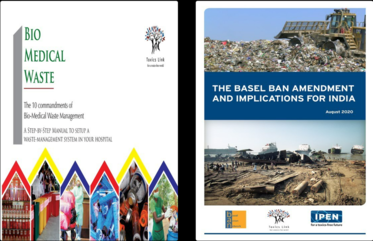Emission of carbon dioxide and Green House Gases
GOVERNMENT OF INDIA
MINISTRY OF ENVIRONMENT, FOREST AND CLIMATE CHANGE
RAJYA SABHA
UNSTARRED QUESTION NO. 2428
TO BE ANSWERED ON 10.08.2023
Emission of carbon dioxide and Green House Gases
2428 DR. C.M. RAMESH:
Will the MINISTER OF ENVIRONMENT, FOREST AND CLIMATE CHANGE be pleased to state:
(a) whether India is the largest emitter of carbon dioxide and Green House Gases, if so, details thereof;
(b) whether Government proposes to Constitute any Committee to identify the reasons as above, the details thereof and if not, the reasons therefor; and
(c) the steps taken by Government to combat these environmental issues during the last three years and details of fund earmarked and utilised in this regard?
ANSWER
MINISTER OF STATE IN THE MINISTRY OF ENVIRONMENT, FOREST AND CLIMATE CHANGE(SHRI ASHWINI KUMAR CHOUBEY)
(a) to (c) India’s annual emissions are well below the three leading emitters – China, United States of America and the European Union. In per capita terms, India’s annual emissions are even lower, and India ranks well below the world average among countries for their per capita emissions. In terms of cumulative emissions, India has contributed less than 4 per cent of the global cumulative emissions from 1850 until 2019.
The national emissions must be judged both by the equity in mitigation and in the light of climate actions being undertaken. On both grounds, India, relative to its responsibility and relative to what equity demands, is doing far more than its fair share. With more than 80% of the global carbon budget, for keeping global temperature increase below 1.5oC by 2100, having already been consumed mostly by developed countries (since 1850), countries like India are left with very little carbon space for the future. The continuing high emissions of developed countries eat into even this reduced entitlement for India. Despite this, India has chosen to walk its climate talk, conscious of the need to pioneer a sustainable development pathway for the entire globe, while attending to the needs and aspirations of its people, economy and society. India’s climate actions across various sectors are embedded in various programmes and schemes. The National Action Plan on Climate Change (NAPCC) provides the overarching framework for all climate actions and comprises missions in specific areas of solar energy, enhanced energy efficiency, sustainable habitat, water, sustaining Himalayan ecosystems, Green India, sustainable agriculture, human health and strategic knowledge for climate change.
All these Missions are institutionalized and implemented by their respective nodal Ministries/Departments, including allocation of funds under their relevant schemes as a part of their annual budgetary allocations. Further, thirty-four States/Union Territories (UTs) have prepared their State Action Plans on Climate Change (SAPCC) in line with NAPCC taking into account the State specific issues relating to climate change. The responsibility of the implementation of the SAPCCs rest with the respective States. Under the Paris Agreement in 2015, India had submitted its Nationally Determined Contribution (NDC) balancing the concerns and priorities of climate change, sustainable development including poverty eradication, and economic growth of the country. In August 2022, India updated its NDC according to which India has an enhanced target to reduce emissions intensity of its GDP by 45 percent by 2030 from 2005 level, achieve about 50 percent cumulative electric power installed capacity from non-fossil fuel-based energy resources by 2030. India’s climate actions have so far been largely financed through domestic resources. Union Budget, 2020-21 stated that India’s NDC commitments as action will be executed in various sectors by the Departments/Ministries concerned through the normal budgeting process. The successive Union Budgets have scaled up the efforts towards mobilizing resources for climate action. The Union Budget 2023-24 places greening the economy as one of top seven priorities. The Budget indicated many programmes such as green fuel, green energy, green farming, green mobility, green buildings, and green equipment, and policies for efficient use of energy across various economic sectors. In particular, an outlay of Rs 19,700 crores under National Green Hydrogen Mission has been allocated to facilitate transition to low carbon economy. The target is to reach an annual production of 5 MMT by 2030. The Budget also provides Rs 35,000 crore for priority capital investments towards energy transition and net zero objectives, and energy security.
Estimating the cost of climate action involves many technical and empirical limitations and based on a number of assumptions. Although the spending on certain key sectors, such as agriculture, water, coastal, energy, and disaster management are considered, there may still be many missing and unknown aspects. While estimates at the source level are subject to uncertainty, it is clear that estimating actual finance expenditure is difficult as there will be various climate co-benefits across various Programmes/Schemes of the Government.
Apart from resolutely addressing climate change domestically, India has launched international coalitions such as International Solar Alliance (ISA) and Coalition for Disaster Resilient Infrastructure (CDRI). At 26th Session of Conference of Parties to UNFCCC in Glasgow, new initiatives under CDRI and ISA, viz, Infrastructure for Resilient Island States (IRIS) and Green Grids Initiative—One Sun One World One Grid (GGI-OSOWOG) were also launched. Along with Sweden, India co-leads the Leadership Group for Industry Transition. (LeadIT) for voluntary low carbon transition of hard to abate sectors.






